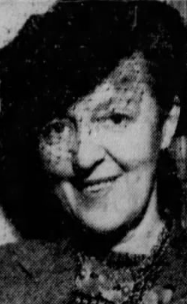Lu Duble
Lu Duble (January 21, 1896 — August 8, 1970), born Lucinda Davies, was an English-born American artist. She was awarded a Guggenheim Fellowship in 1937 and 1938, to study art and sculpture in Haiti.
Early life and education
[edit]Lucinda Christine Davies was born in 1896, in Oxford, England, the daughter of John Walter Davies and Marianne Mogridge Davies. Her father was an author, editor, and journalist.[1] Her mother's grandfather was author George Mogridge.[2] She moved to the United States with her parents in 1903, as a young child. Davies trained at the Art Students League and Cooper Union in New York City. Her mentors included Alexander Archipenko, Jose de Creeft, and Hans Hofmann.[3]
Career
[edit]From 1918 to 1937, Duble was head of the sculpture program at Bennett Junior College in Millbrook, New York.[4] She also taught sculpture classes at Brearley School, Dalton School, Greenwich House, and Montclair Art Museum.[2] She was awarded a Guggenheim Fellowship in 1937 and 1938, to study art and sculpture in Haiti.[5][6] Another travel fellowship, from the Institute of International Education, sent her to Mexico from 1942 to 1944, where she made sculptures[7] and studied Mayan art.[8]
Duble's best known works were human figures or heads, worked in stone, cement, and terracotta.[7] Her sculpture, "Calling the Loa, Haiti" won the Anna Hyatt Huntington Prize in 1938,[9] and "Last Migration" won the Speyer Prize in 1952.[10] She had work in the fiftieth anniversary show of the National Association of Women Painters and Sculptors in 1939.[11] In 1940, Duble showed her sculptures from Haiti at the Dayton Art Institute;[12] local arts editor Merab Eberle found the show's "voodooistic" theme disturbing, but agreed that Duble had "rhythmic sense and no small degree of ability to impart power."[13] She was part of a three-woman show, at Grand Central Art Galleries in 1947, with Cornelia Chapin and Marion Sanford.[14] She "tackles themes that are deeply felt, in forms that are impressionistically modeled and full of dramatic tensions," wrote a Philadelphia reviewer in 1950, adding "Lu Duble's work must be respected but can't always be enjoyed."[15]
She was a member of the National Association of Women Painters and Sculptors from 1937,[16] a fellow of the National Sculpture Society, elected in 1937,[17] and a member of the National Academy of Design from 1942.[18][19] She was part of a group of women artists called informally "the Guild ladies", including Dorothy Dehner, Helen Wilson, Rhys Caparn and Helena Simkhovitch.[20] Among her students were artists Ray Eames[21] and Mercedes Matter.[22]
Personal life
[edit]Davies married twice, first in 1917 to Jesse Clyde Duble, and second to Alfred Geiffert Jr., a landscape architect. She was widowed when Geiffert died in 1957.[23] She spent summers in Woodstock, New York in her later years. She died in 1970, in Woodstock, aged 74 years.[8] She was survived by her sister, Gwen, also an artist.[10]
References
[edit]- ^ Leonard, John William; Mohr, William Frederick; Holmes, Frank R.; Knox, Herman Warren; Downs, Winfield Scott (1907). Who's Who in New York City and State. L.R. Hamersly Company. pp. 380.
Marianne Mogridge Davies.
- ^ a b "Lu Duble Gets Museum Post". The Montclair Times. September 27, 1940. p. 7. Retrieved October 30, 2019 – via Newspapers.com.
- ^ Jules Heller and Nancy G. Heller, eds., North American Women Artists of the Twentieth Century (Routledge 2013): 1676-1677. ISBN 9781135638894
- ^ "Bennett School Teacher Gets Guggenheim Award". Poughkeepsie Eagle-News. March 29, 1937. p. 1. Retrieved October 30, 2019 – via Newspapers.com.
- ^ "Lu Duble". John Simon Guggenheim Foundation. Retrieved 2019-10-29.
- ^ "Duble to be Speaker for Preview at Institute". Dayton Daily News. January 21, 1940. p. 29. Retrieved October 30, 2019 – via Newspapers.com.
- ^ a b Miller, Gladys (June 6, 1947). "Room Can Be Planned Around Good Piece of Sculpture". The Daily Oklahoman. p. 30. Retrieved October 29, 2019 – via Newspapers.com.
- ^ a b "Lu Duble Dies, Was Sculptor and Teacher". The Kingston Daily Freeman. August 11, 1970. p. 4. Retrieved October 30, 2019 – via Newspapers.com.
- ^ "$1,300 Prizes Given to Women Artists". The New York Times. January 4, 1938. p. 25 – via ProQuest.
- ^ a b "Lu Duble is Dead; Sculptor was 74" New York Times (August 9, 1970): 65. via ProQuest
- ^ A. Z. Kruse, "Art: Women Painters and Sculptors Hold Fiftieth Exhibit" Brooklyn Daily Eagle (August 13, 1939): 29. via Newspapers.com

- ^ "Strange Customs of Haitian Natives Told by Sculptor". Dayton Daily News. February 1, 1940. p. 2. Retrieved October 30, 2019 – via Newspapers.com.
- ^ Eberle, Merab (January 28, 1940). "Voodoo Dancers are Sculptured". The Journal Herald. p. 25. Retrieved October 30, 2019 – via Newspapers.com.
- ^ Chapin, Cornelia; Duble, Lu; Sanford, Marion; Grand Central Art Galleries (1947). 3 sculptors: Chapin, Duble, Sanford. New York: Grand Central Art Galleries, Inc. OCLC 197992392.
- ^ Benson, Gertrude (November 19, 1950). "Contemporary Art Show Salutes Industry". The Philadelphia Inquirer. p. 92. Retrieved October 30, 2019 – via Newspapers.com.
- ^ "Women Artists Elect". The New York Times. March 27, 1937. p. 12 – via ProQuest.
- ^ "Historic Members". National Sculpture Society. Retrieved 2019-10-29.
- ^ "Academicians". National Academy of Design. Retrieved 2019-10-29.
- ^ "Miss Duble Elected to Academy of Design". Poughkeepsie Journal. April 20, 1942. p. 10. Retrieved October 30, 2019 – via Newspapers.com.
- ^ Daniel Belasco, "Between the Waves: Feminist Positions in American Art, 1949-1962" (PhD dissertation, New York University, 2008): 156.
- ^ Kirkham, Pat. "Ray Kaiser Eames". Pioneering Women of American Architecture. Retrieved 2019-10-29.
- ^ "Mercedes Matter, Biography". Cavalier Galleries. Retrieved 2019-10-29.
- ^ "Alfred Geiffert, Garden Designer". The New York Times. August 27, 1957. p. 27 – via ProQuest.

